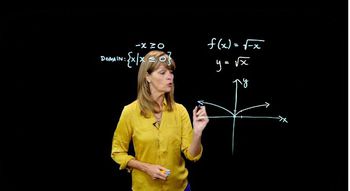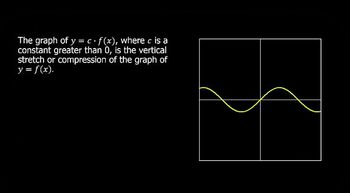Table of contents
- 0. Review of Algebra4h 16m
- 1. Equations & Inequalities3h 18m
- 2. Graphs of Equations43m
- 3. Functions2h 17m
- 4. Polynomial Functions1h 44m
- 5. Rational Functions1h 23m
- 6. Exponential & Logarithmic Functions2h 28m
- 7. Systems of Equations & Matrices4h 6m
- 8. Conic Sections2h 23m
- 9. Sequences, Series, & Induction1h 19m
- 10. Combinatorics & Probability1h 45m
3. Functions
Transformations
Problem 85
Textbook Question
Graph each function. See Examples 6–8 and the Summary of Graphing Techniques box following Example 9. ƒ(x)=2√x+1
 Verified step by step guidance
Verified step by step guidance1
Identify the basic function: The function \( f(x) = 2\sqrt{x+1} \) is a transformation of the basic square root function \( \sqrt{x} \).
Determine the transformations: The expression \( x+1 \) inside the square root indicates a horizontal shift to the left by 1 unit. The coefficient 2 outside the square root indicates a vertical stretch by a factor of 2.
Find the domain: Since the square root function is only defined for non-negative numbers, set the expression inside the square root greater than or equal to zero: \( x+1 \geq 0 \). Solve for \( x \) to find the domain: \( x \geq -1 \).
Identify key points: Start with the vertex of the basic function, which is at \( (0,0) \). Apply the transformations to find the new vertex: \( (-1,0) \). Calculate additional points by choosing values of \( x \) greater than or equal to -1 and finding corresponding \( y \) values.
Sketch the graph: Plot the vertex and additional points on the coordinate plane. Draw a smooth curve starting from the vertex and extending to the right, reflecting the shape of the square root function with the applied transformations.
 Verified video answer for a similar problem:
Verified video answer for a similar problem:This video solution was recommended by our tutors as helpful for the problem above
Video duration:
1mPlay a video:
Was this helpful?
Key Concepts
Here are the essential concepts you must grasp in order to answer the question correctly.
Function Definition
A function is a relation that assigns exactly one output for each input from its domain. In the case of ƒ(x) = 2√x + 1, the function takes a non-negative input x, applies the square root, scales it by 2, and then shifts the result up by 1. Understanding the definition of a function is crucial for graphing, as it helps identify the relationship between x and ƒ(x).
Recommended video:

Graphs of Common Functions
Graphing Techniques
Graphing techniques involve methods for visually representing functions on a coordinate plane. This includes identifying key features such as intercepts, asymptotes, and the overall shape of the graph. For the function ƒ(x) = 2√x + 1, recognizing that it is a transformation of the basic square root function will aid in accurately plotting its graph.
Recommended video:
Guided course

Graphs and Coordinates - Example
Transformations of Functions
Transformations of functions refer to changes made to the basic form of a function that affect its graph. These can include vertical shifts, horizontal shifts, stretches, and compressions. In ƒ(x) = 2√x + 1, the factor of 2 indicates a vertical stretch, while the +1 indicates a vertical shift upwards, both of which are essential for accurately graphing the function.
Recommended video:

Domain & Range of Transformed Functions

 5:25m
5:25mWatch next
Master Intro to Transformations with a bite sized video explanation from Nick Kaneko
Start learningRelated Videos
Related Practice

























